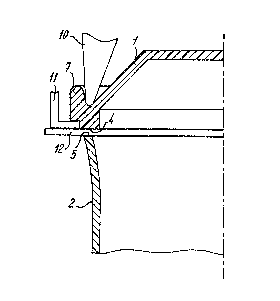Some of the information on this Web page has been provided by external sources. The Government of Canada is not responsible for the accuracy, reliability or currency of the information supplied by external sources. Users wishing to rely upon this information should consult directly with the source of the information. Content provided by external sources is not subject to official languages, privacy and accessibility requirements.
Any discrepancies in the text and image of the Claims and Abstract are due to differing posting times. Text of the Claims and Abstract are posted:
| (12) Patent: | (11) CA 1264216 |
|---|---|
| (21) Application Number: | 1264216 |
| (54) English Title: | PROCESS AND DEVICE FOR CONNECTING TOGETHER BY HEATED- TOOL BUTT-WELDING A VESSEL BODY OBTAINED BY EXTRUSION AND A VESSEL LID |
| (54) French Title: | METHODE ET DISPOSITIF DE RACCORDEMENT PAR SOUDAGE ABOUTE A L'OUTIL CHAUFFE, DU CORPS EXTRUDE D'UN CONTENANT ET DE SON COUVERCLE |
| Status: | Expired and beyond the Period of Reversal |
| (51) International Patent Classification (IPC): |
|
|---|---|
| (72) Inventors : |
|
| (73) Owners : |
|
| (71) Applicants : |
|
| (74) Agent: | GOWLING WLG (CANADA) LLP |
| (74) Associate agent: | |
| (45) Issued: | 1990-01-09 |
| (22) Filed Date: | 1986-07-16 |
| Availability of licence: | N/A |
| Dedicated to the Public: | N/A |
| (25) Language of filing: | English |
| Patent Cooperation Treaty (PCT): | No |
|---|
| (30) Application Priority Data: | None |
|---|
ABSTRACT
Process and device for connecting together an extruded plastic
cylindrical vessel body (2) with a plastic lid (1) by means of butt-
welding of edges (4.5) heated with a heated plate (12) the said lid
being deformed elastically to a larger diameter prior to butt-welding,
the device for expanding the lid (1) having a conical expansion element
(9), a supporting ring (10) and locking elements (11) holding the
expanded lid at a diameter corresponding to the edge diameter of the
body (2).
Note: Claims are shown in the official language in which they were submitted.
Note: Descriptions are shown in the official language in which they were submitted.

2024-08-01:As part of the Next Generation Patents (NGP) transition, the Canadian Patents Database (CPD) now contains a more detailed Event History, which replicates the Event Log of our new back-office solution.
Please note that "Inactive:" events refers to events no longer in use in our new back-office solution.
For a clearer understanding of the status of the application/patent presented on this page, the site Disclaimer , as well as the definitions for Patent , Event History , Maintenance Fee and Payment History should be consulted.
| Description | Date |
|---|---|
| Time Limit for Reversal Expired | 2003-01-09 |
| Letter Sent | 2002-01-09 |
| Inactive: Entity size changed | 2000-01-07 |
| Letter Sent | 1999-08-12 |
| Letter Sent | 1999-08-12 |
| Inactive: Multiple transfers | 1999-05-10 |
| Grant by Issuance | 1990-01-09 |
There is no abandonment history.
| Fee Type | Anniversary Year | Due Date | Paid Date |
|---|---|---|---|
| Reversal of deemed expiry | 1999-01-11 | 1998-01-05 | |
| MF (category 1, 8th anniv.) - small | 1998-01-20 | 1998-01-05 | |
| MF (category 1, 9th anniv.) - small | 1999-01-11 | 1998-12-15 | |
| Reversal of deemed expiry | 1999-01-11 | 1998-12-15 | |
| Registration of a document | 1999-05-10 | ||
| MF (category 1, 10th anniv.) - standard | 2000-01-10 | 1999-12-16 | |
| MF (category 1, 11th anniv.) - standard | 2001-01-09 | 2001-01-09 |
Note: Records showing the ownership history in alphabetical order.
| Current Owners on Record |
|---|
| KONINKLIJKE EMBALLAGE INDUSTRIE VAN LEER N.V. |
| Past Owners on Record |
|---|
| BERNARD JOHAN DE LOOS |
| EDWARD JAMES FARRINGTON |
| GERRIT JAN VAN KEIMPEMA |